
11 November 2024
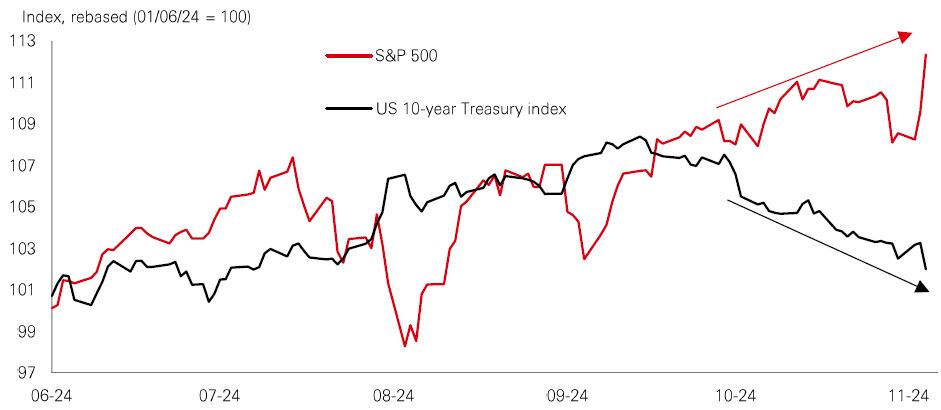
The S&P 500 hit fresh all-time highs last week with the decisive outcome of the US presidential election removing one form of uncertainty for investment markets. US stocks also found a fresh catalyst via the potential for lower corporate tax rates and deregulation, boosting the profits outlook.
The recent good run in US stocks has coincided with a period of rising US Treasury yields. Investors are grappling with a likely combination of ongoing fiscal activism, global economic fragmentation, renewed inflationary pressures, and a shallower Fed rate cutting cycle.
So far, the stock market has shrugged off the pick-up in yields. But there is no guarantee that higher-for-longer rates won’t damage risk appetite. Investment markets have been “hypersensitive” to economic news this year. The addition of policy uncertainty could intensify market volatility.
US stock valuations look stretched and profits expectations are elevated. Positive European and Asian growth in 2025 suggests there is still room for markets outside of the US to perform. But for emerging markets, the dollar outlook is key, as is the next set of policy support measures from China.
The Fed looked through the noise of the US elections and delivered a 0.25% cut, which it had been expected to do for several weeks. The rationale for the move was that the funds rate is at restrictive levels while inflation is moderating, and the labour market is back in better balance.
Looking forward, the Fed is faced with a more uncertain outlook, given potentially large changes in fiscal and trade policy. Medium-term upside inflation risks have likely increased while the growth outlook has become more ambiguous – depending on the ultimate mix of fiscal and trade policies, growth could exceed or disappoint current expectations.
Given the more unpredictable outlook, Chair Powell may want to recall the words of former ECB President Mario Draghi, “In a dark room you move with tiny steps”. In other words, the best course of action is likely to be gradually taking the policy rate back towards a more neutral level unless data and events push you strongly to do something else.
The value of investments and any income from them can go down as well as up and investors may not get back the amount originally invested. Past performance does not predict future returns. Investments in emerging markets are by their nature higher risk and potentially more volatile than those inherent in some established markets. The level of yield is not guaranteed and may rise or fall in the future. For informational purposes only and should not be construed as a recommendation to invest in the specific country, product, strategy, sector or security. Any views expressed were held at the time of preparation and are subject to change without notice. Any forecast, projection or target where provided is indicative only and not guaranteed in any way. Diversification does not ensure a profit or protect against loss.
Source: HSBC Asset Management. Macrobond, Bloomberg. Data as at 7.30am UK time 08 November 2024.
Chinese stocks rallied in September on news of further policy support, and they’ve largely held those gains. Momentum picked up in early November, and the Shanghai Composite is still up 20%+ since the new measures were announced. Last week, the China National People’s Congress (NPC) Standing Committee approved an incremental increase of RMB6 trillion in the local government special debt limit to swap hidden debt over three years through the end of 2026.
For stocks, the prospect of further policy support could mean strong potential for growth and recovery. Some specialists see Chinese stocks continuing to trade at a wide discount to peers and still lightly-owned by international investors. They favour both quality growth companies and high dividend-paying stocks. That said, Chinese firms remain vulnerable to potential risks, including geopolitical tensions and any weakness in global economic conditions.

President-elect Trump’s victory in the US election, together with a strengthening dollar, has reinforced negative sentiment towards emerging market (EM) currencies and local-currency assets. Investors have been nervous about the potential impact of higher US tariffs on global trade, as well as potentially higher bond issuance and a widening of the US fiscal deficit. A repricing of US rate expectations hasn’t helped EM assets either.
Weaker EM currencies risk stoking inflation and could prompt a re-assessment of the EM policy outlook. Brazil’s central bank hiked rates by 0.50% in October to quell rising inflation, providing relief for the currency. The Brazilian real has weakened nearly 14% this year – hitting a record low following the US election – maintaining the pressure for further tightening amid rising concerns about the sustainability of fiscal policy. While this is a near-term risk for many EM economies, a number of currencies have long-term valuation buffers. The Fed-driven global easing cycle, albeit possibly slower and shallower, should limit downside risks, as should the policy-stimulus driven cyclical recovery in China.
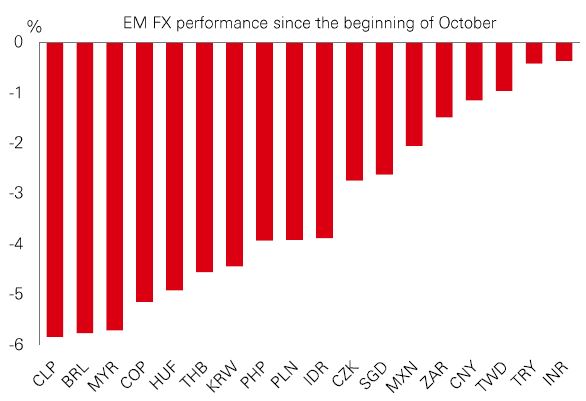
A concern for investors ahead of the US election was the potential impact on global trade from aggressive US tariffs. One area which could prove resilient to greater trade frictions is frontier markets, where countries have learnt to steer a path between competing third parties.
Key to this is that frontiers are a relatively low correlation, low volatility asset class in the equity space, with domestically-driven economies. That can shelter them from global macro events. The shift towards a more multi-polar world has tested this, but frontiers are tending to prioritise neutrality.
In Gulf Cooperation Countries, for example, Saudi Arabia has opted to play a mediator role in regional tensions, preferring instead to focus on its domestic economy, social reforms, and diversifying from oil into sectors like tourism and leisure. Another example is Vietnam, which has managed to benefit from ’nearshoring’ but still maintains a positive trade partnership with both China and the US. All in, frontier markets could offer a route through potential tariff tensions.
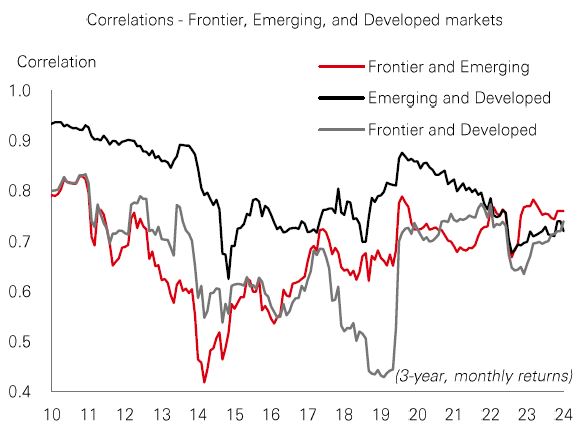
Past performance does not predict future returns. The level of yield is not guaranteed and may rise or fall in the future. For informational purposes only and should not be construed as a recommendation to invest in the specific country, product, strategy, sector or security. Any views expressed were held at the time of preparation and are subject to change without notice.
Source: HSBC Asset Management. Macrobond, Bloomberg, Datastream. Data as at 7.30am UK time 08 November 2024.
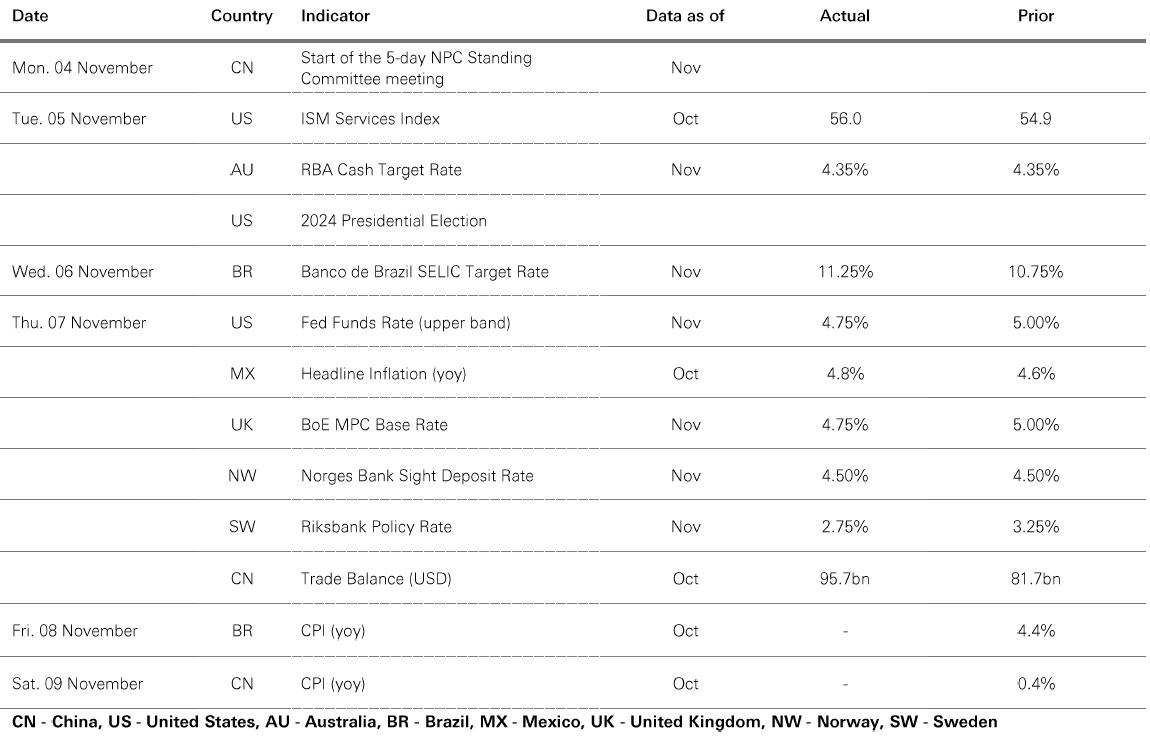
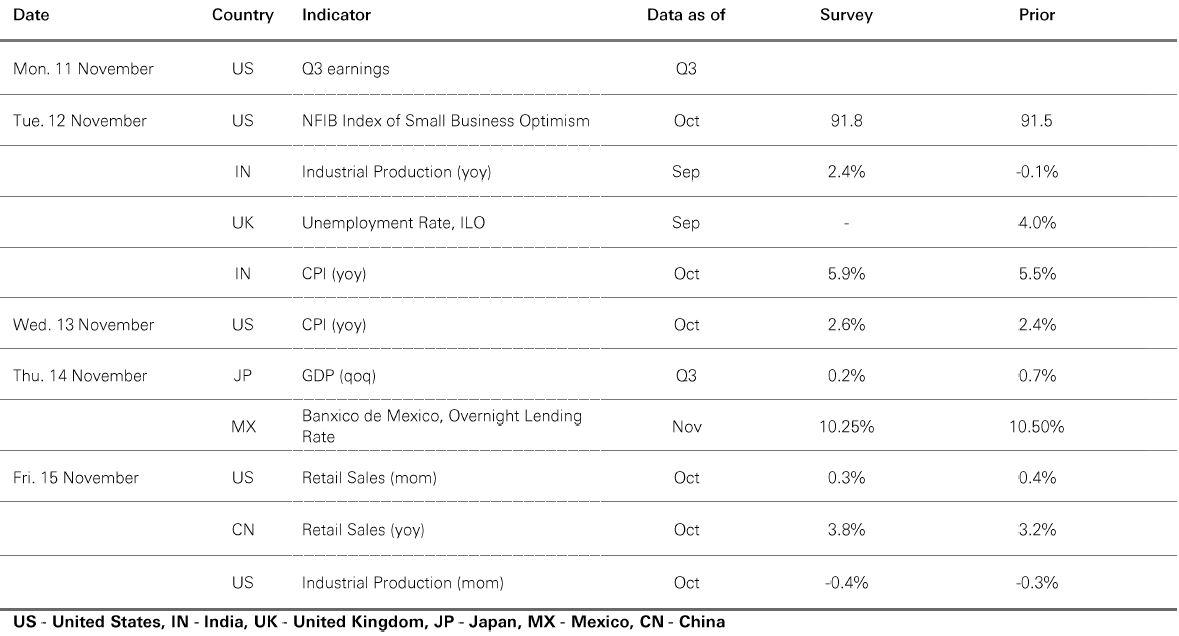
Source: HSBC Asset Management. Data as at 7.30am UK time 08 November 2024. For informational purposes only and should not be construed as a recommendation to invest in the specific country, product, strategy, sector or security. Any views expressed were held at the time of preparation and are subject to change without notice.
Risk appetite rose following the presidential election in the US, with the US dollar strengthening on expectations of continued “US exceptionalism” and looser fiscal policy. Core government bonds weakened, with rising US fiscal concerns lifting US Treasury yields, led by the 10yr. The Fed lowered rates by 0.25%, hinting at a more cautious view on inflation, and the BoE lowered rates by 0.25%. In the US, equities saw broad-based gains, with the S&P500 reaching an all-time high. European stocks weakened, led by lower autos. The Nikkei 225 advanced, as the Japanese yen hovered around its 3-month low. In EM, mainland China’s Shanghai composite rallied on encouraging business surveys amid optimism over further fiscal stimulus. Hong Kong’s Hang Seng index and Korea’s Kospi moved higher. In commodities, OPEC+’s decision to delay production cuts supported oil prices. Gold fell, while copper edged higher.





We’re not trying to sell you any products or services, we’re just sharing information. This information isn’t tailored for you. It’s important you consider a range of factors when making investment decisions, and if you need help, speak to a financial adviser.
As with all investments, historical data shouldn’t be taken as an indication of future performance. We can’t be held responsible for any financial decisions you make because of this information. Investing comes with risks, and there’s a chance you might not get back as much as you put in.
This document provides you with information about markets or economic events. We use publicly available information, which we believe is reliable but we haven’t verified the information so we can’t guarantee its accuracy.
This document belongs to HSBC. You shouldn’t copy, store or share any information in it unless you have written permission from us.
We’ll never share this document in a country where it’s illegal.
This document is prepared by, or on behalf of, HSBC UK Bank Plc, which is owned by HSBC Holdings plc. HSBC’s corporate address is 1 Centenary Square, Birmingham BI IHQ United Kingdom. HSBC UK is governed by the laws of England and Wales. We’re authorised by the Prudential Regulation Authority (PRA) and regulated by the Financial Conduct Authority (FCA) and the PRA. Our firm reference number is 765112 and our company registration number is 9928412.